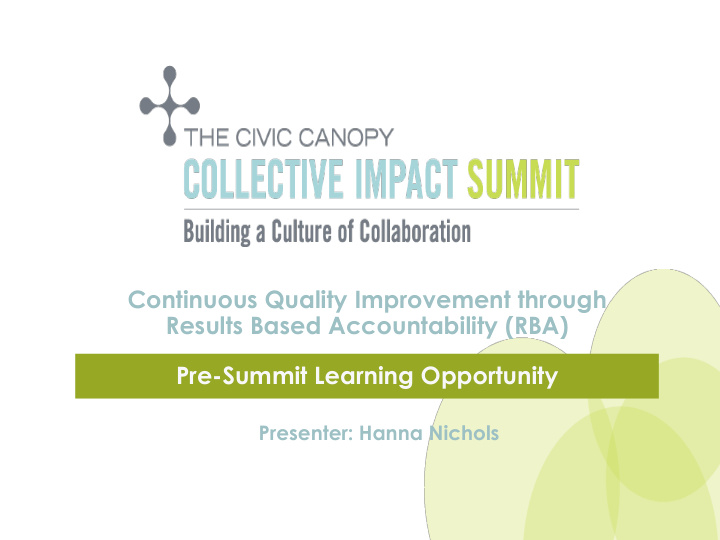



Continuous Quality Improvement through Results Based Accountability (RBA) Pre-Summit Learning Opportunity Presenter: Hanna Nichols
The Civic Canopy Helping the many work as one for the good of all • Building Connections • Building Capacity • Building a Movement
The Canopy Summit: Pre-Summit Learning Opportunities • Next Pre-Summit Learning Opportunity • Summit! • No Novemb ember er 29 29 – Dec Decemb ember er 1, 2 1, 201 016 6 in in Den Denver er This multi-day, interactive learning • experience is designed to enhance skills and practice in inclusive, collaborative processes that result in real social change. Learn more and register: • www.civiccanopy.org/summit
Desired Outcomes 1 Participants understand shared measurement as a key element of collaborative efforts 2 Participants understand the basic concepts of Results Based Accountability (RBA) 3 Participants feel confident and excited about attending Summit workshops connected to Shared Measurement
Much of our material is adapted from
Sound familiar? • “Problems in my community are so big and complex that it’s too much to take on.” • “I’m just going to my best to make change in my small corner of the world and hope things happen.”
Source: New Yorker Magazine, 1991
Shared Measurement • One element of collective impact • Measuring progress toward your shared goals • More challenging than it might seem – especially when considering large social problems with multiple contributors
1 RBA Fundamentals (and a poll!)
Results Based Accountability • Disciplined process of moving from desired result to concrete action steps • Starts with ends and works backwards to means . • Designed to be common-sensible, not jargonny • Emphasizes use of data to inform decisions
A Leaking Roof: Results Thinking in Everyday Life Experience: Not OK Inches of Water Measure: ? Fixed Turning the Curve Story behind the baseline (causes): Partners: What Works: Action Plan:
Results Accountability Population Accountability about the well-being of WHOLE POPULATIONS For Communities – Cities – Counties – States - Nations Performance Accountability about the well-being of CLIENT POPULATIONS For Programs – Agencies – and Service Systems
Definitions RESULT A condition of well-being for children, adults, families or Accountability Population communities. Children born healthy, Children ready for school, Safe communities, Clean Environment, Prosperous Economy INDICATOR A measure which helps quantify the achievement of a result. Rate of low-birthweight babies, Percent ready at K entry, crime rate, air quality index, unemployment rate PERFORMANCE MEASURE Performance Accountability A measure of how well a program, agency or service 1. How much did we do? system is working. 2. How well did we do it? 3. Is anyone better off?
Language discussion What’s important is always going back to the idea. Ideas Group 1 Group 2 Group 3 1. A condition of RESULT OUTCOME GOAL well-being for children, adults, families and the community.
Population Level Accountability • It’s always tempting to go straight to what we think works, but going immediately to action ≠ results • So, the question is to start with the ENDS and THEN focus on the means to get there.
Population Level Accountability The first question we need to ask is “what does success look like?”
Population Level Accountability Examples of Results Early Childhood Colorado Larimer County Early Prowers County Collective Partnership Childhood Council Impact Team • • Young children reach their All children are valued, All Prowers County developmental potential and healthy and thriving residents are physically are ready to succeed in school active and in life • All Prowers County • Adults are knowledgeable, residents eat healthy responsible, and interact effectively on behalf of young foods children • Families choose to stay, • Environments that impact live and invest in Prowers children are safe, stable, and County supportive • Localities and the state attain economic and social benefits by prioritizing children and families
Performance Level Accountability
Drug/Alcohol Treatment Program Quantity Quality How much service did we How well did we deliver deliver? it? Percent of Number of Effect Effort staff with persons training/ treated certification How much change/effect did What quality of we produce? change/effect did we produce? Number of clients Percent of clients off of alcohol & drugs off of alcohol & drugs - at exit - at exit - 12 months after exit - 12 months after exit
Who are your clients? • Important to distinguish between your service delivery system and your clients • Many of us picture children as our clients, but in many cases, they are NOT our clients • So, who are your clients? Where is there overlap? Opportunity to collaborate?
Let’s practice! Result, indicator, or performance measure? • # of hours community partners contributed to Council Performance measure work • Families are engaged as leaders in their child’s Result development and learning • % of child care programs achieving and maintaining a 2 – 5 quality rating Indicator Indicator • Childhood obesity rates
1 Turn the Curve
Turn rn – the – Curve e Think nkin ing Resu esult lt 5 How are Indicator 4.5 4 we Doing? Baseline 3.5 3 2.5 2 1.5 Story behind Why? 1 the baseline 0.5 0 Who can Partners Help? Options? What works What is the Strategic Action Plan Action?
Turn the Curve Example: Prowers County
Turn the Curve Example: Prowers County
Turn the Curve Example: Prowers County
Turn the Curve Example: Prowers County
Resources RBA Implementation Guide: http://raguide.org/ Results Leadership Group: http://resultsleadership.org/ The Civic Canopy: www.civiccanopy.org
No Novemb ember er 29 29 – Dec Decemb ember er 1, 1, 2016 2016 in in De Denver er This multi-day, interactive learning experience is designed to enhance skills and practice in inclusive, collaborative processes that result in real social change. Learn more and register: www.civiccanopy.org/summit In partnership with Tamarack Institute
Recommend
More recommend